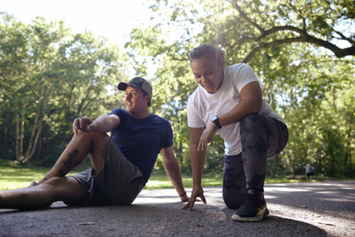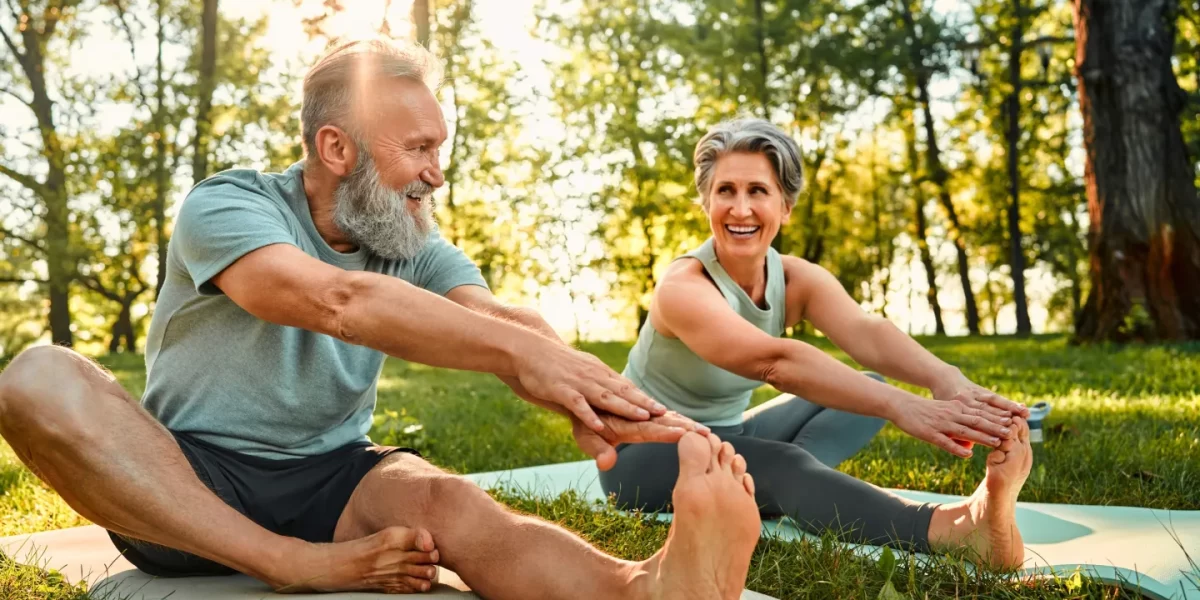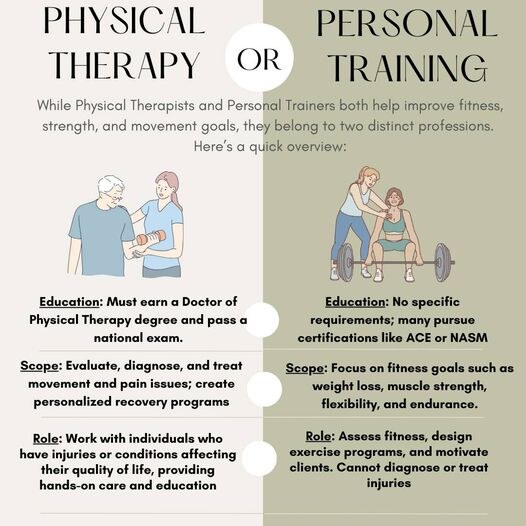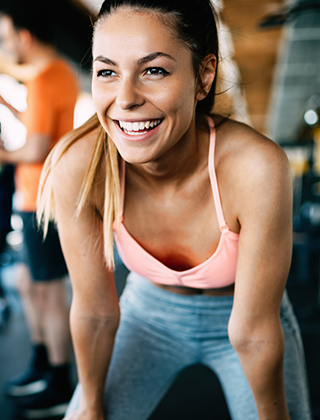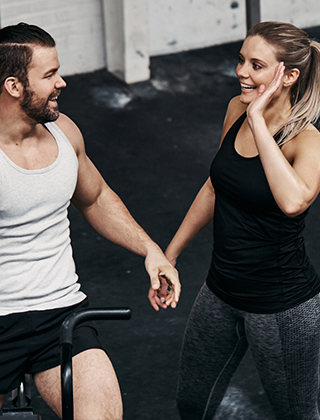Spring is in the air, even in those parts of the country that have seen freezing winter storms. With warmer weather comes a desire to get outside, get active, and shed some of the weight with a spring fitness plan that might have been gained during winter months.
Exercising alone or only with your partner is still a great way to make good on your spring fitness goals while enjoying the nice weather.
Get the full effects of Spring fitness
Did you know that exercising regularly affects more than just physical fitness? You might be surprised to discover that exercise makes you more likely to:
- Live longer
- Sleep well at night
- Be in a good mood
- Control your weight
The Fitness Zone has five tips to help you put your best foot forward when you’re keeping fit in the heat.
1. Warm-up and cool-down
Always include a warm-up and cool-down as a part of your exercise routine. A tough workout can lead to muscle strain and injury if your body does not ease in and out of physical activity. Include stretching after your cool-down routine to increase flexibility. Muscles will still be warm and more flexible, which will allow you to move through a fuller range of motion.
2. Wear proper footwear
It’s important to choose the right clothing and footwear. Both should be comfortable and safe. You might think that your flip-flops or slippers are the most comfortable shoes you own, but they are not appropriate for working out. For exercising, be sure to have properly fitted athletic shoes with good arch support. The right shoes will prevent too much stress on your feet and knees and will help you from stumbling on obstacles in your path.
3. Don’t overdo it
For many Veterans, starting a brisk walking program may be more appropriate than running at full speed. Begin by taking it easy on your joints and work your way towards finding the point at which you are challenged. Remember: you’re not a new recruit doing physical training in basic training anymore. Get into your workout program step by step to avoid injury and burnout. And keep in mind, if you’re training outdoors, you always need to get back home. So be careful to pace yourself and don’t go too far in one direction.
4. Track progress
Setting concrete goals and tracking your progress in achieving those goals can be a great motivator. Keep the goals realistic. For example, don’t start your running program by running long distances. As you keep track of your exercise, you will notice your exercise patterns. With those records, you’ll recognize how much progress you’re making, or if your success is dropping off.
5. Drink enough liquids
Working out in the heat and humidity can put you at risk for dehydration, heatstroke, and other heat-related illnesses. The easiest way to avoid heat disorders is to keep your body hydrated. This means drinking liquids before, during, and after your exercise.
Don’t drink the kind of soda or fruit juices that will only make you more dehydrated. Choose water or a low-calorie sports drink. Insufficient liquids will not just leave you feeling uncomfortable, but dehydration can lead to fainting or muscle cramps.
Your target heart rate is 50 to 85 percent of your maximum heart rate. It is the level at which your heart is beating with moderate to high intensity. To determine your maximum heart rate, take 220 and subtract your age.
Help your heart work stronger
Cardiovascular exercise (also called aerobic exercise) is especially effective in keeping your heart healthy and reaching your target heart rate. This specific type of exercise gets your heart beating fast for several minutes at a time.
Target heart rate is defined as the minimum number of heartbeats in a given amount of time to reach the level of exertion necessary for cardiovascular fitness, specific to a person’s age, gender, or physical fitness.
The following is an estimate given by the American Heart Association for target heart rate numbers for adults:
| Age | Target Heart Rate Zone (50-85%) | Average Maximum Heart Rate (100%) |
|---|---|---|
| 20 | 100 to 170 beats per minute | 200 bpm |
| 30 | 95-162 bpm | 190 bpm |
| 35 | 93-157 bpm | 185 bpm |
| 40 | 90-153 bpm | 180 bpm |
| 45 | 88-149 bpm | 175 bpm |
| 50 | 85-145 bpm | 170 bpm |
| 55 | 83-140 bpm | 165 bpm |
| 60 | 80-136 bpm | 160 bpm |
| 65 | 78-132 bpm | 155 bpm |
| 70 | 75-128 bpm | 150 bpm |
| 75 | 73-123 bpm | 145 bpm |
| 80 | 70-119 bpm | 140 bpm |
| 85 | 68-113 bpm | 135 bpm |
| 90 | 65-111 bpm | 130 bpm |
Measure your heart rate
To determine your heart rate, use your first two fingers to press lightly over the blood vessels on your inner wrist—the side by your thumb. Count your pulse for ten seconds and multiply this number by six.
If your heart rate is 50 to 85 percent of your maximum heart rate, you have hit your target heart zone and are working at the right level of intensity.
Wearing a fitness tracker can help do the work for you. The device is worn like a bracelet or watch and measures your heart rate.
Exercising at the right level of intensity improves heart and respiratory endurance and helps keep your workout at a level that is vigorous enough to meet your health goals.
A final note
If you have a heart condition, discuss your heart rate with your doctor before starting an exercise program.

Staying fit should incorporate mental and emotional fitness as well.
Dr. Bill Dorfman, a 64-year-old cosmetic dentist in Southern California, prides himself on looking years younger, a characteristic he attributes to good genes and a daily workout regimen that helps staying fit
Three days a week he focuses on abs and cardio; the other days are for lifting light weights at high reps.
Dorfman says he got serious about exercise following a lull during dental school when he found himself frequently in pain. That’s when he realized his fitness had taken a back seat following years as a high school swimmer and gymnast. “What I found was the more I exercised, the better I felt,” he says.
Outside of the gym, he credits his daily Words With Friends habit with keeping his mind sharp. He also makes nightly dinner plans with various friends to stay connected.
Dorfman’s wellness habits underscore that one key to a longer life is a fitness regimen—but one that incorporates mental and emotional fitness as well.
“We really need to look at the life of an older adult with a holistic lens—if they’re really happy, healthy, and whole,” says Dor Skuler, cofounder and CEO of Intuition Robotics and an expert on loneliness in aging adults.
Here are four ways to focus on whole-body fitness as you age.
1. Exercise for the body and brain
Staying physically active and staying fit can prevent injuries and help the body heal faster when they happen, plus it’s also strongly linked to good mental health and brain function.
Kirk Erickson, PhD, director of Translational Neuroscience at AdventHealth Central Florida, where he studies the plasticity and modifiability of brain systems, has found physical activity to be one of the best ways to keep the brain healthy throughout its lifespan.
Erickson’s research shows that as we age, the brain shrinks, specifically the hippocampus, which is responsible for memory formation. Exercise can help maintain this portion of the brain and, in some cases, increase the size. There’s much to be learned about how and why this is, but Erickson says the effects are better the longer you engage in these habits, so it’s good to start young.
Of course you can still reap the benefits if you start later in life, he says. You might find that with time, you can recall memories and information more easily and have better executive function and a longer attention span when your brain is at its best, he says.
He recommends moderate exercise, like walking, five days a week for 30 minutes.
Aside from walking, Dr. Gary Small, chair of psychiatry at Hackensack Meridian Health, says strength training helps combat age-related muscle loss and can lead to a longer lifespan. Additionally, balance exercises can help prevent slips and falls—the leading cause of injuries in adults ages 65 and older.
Jasmine Marcus, a physical therapist at Cayuga Medical Center in Ithaca, N.Y., where she works with patients of all ages and physical activity levels, recommends tiptoeing into exercise if you’re new to it. She suggests starting with some kind of group fitness class like Zumba—anything that elevates your heart rate. It helps, too, if you have a partner to hold you accountable, she says.
2. Strive for mental fitness
Small also recommends doing activities that keep the brain in shape. One study showed the simple act of reading articles online and searching topics on Google offered valuable mental stimulation. Doing crossword puzzles, reading books, playing games, practicing hobbies, and daydreaming all contribute to mental sharpness and staying fit.
Stress management is also a critical part of maintaining mental fitness. Just 10 minutes of meditation a day can improve mood and cognitive agility, says Small, rewiring the brain and strengthening neural circuits.
“You don’t have to go to a retreat in Nepal or India to meditate, but you can learn the skills,” he says.
3. Stay social
The U.S. surgeon general issued an advisory last year warning of the nation’s loneliness epidemic, which negatively impacts health. One study equated lack of social connection to smoking up to 15 cigarettes a day. Other studies show social connection reduces the risk of premature death. It’s clear that social and emotional fitness is key to aging well and staying fit.
Skuler, whose company makes AI-powered social companions for aging adults aimed at keeping them active and engaged, says major life changes, such as the death of a spouse, often trigger loneliness.
“That is by far a watershed moment,” he says. Suddenly no one is asking how you slept or what you have planned for the day. A similar problem happens with asynchronous aging, where one spouse has a decline with dementia, for example. Other events such as retiring or sending the kids off to college might have similar impacts on social well-being, Skuler says.
ElliQ, the robot companion Skuler’s company makes, is one way to help aging adults stay connected, but he encourages all people to maintain friendships and relationships with family members. Volunteering, he says, can also add purpose and connection to your life.
4. Develop good sleep hygiene
There’s a myth that seniors need less sleep as they age, but Jamie Zeitzer, PhD, advisor and scientific reviewer at Rise Science, says the reality is sleep becomes more difficult with age. The result is that many seniors find themselves going to bed later and rising earlier.
“Humans are programmed to stay awake 16 [hours] and sleep eight hours,” he says. “An older person’s ability to do that diminishes, so they have to work a little harder at it.”
The causes for poor sleep can be both social and physical. We become more sensitive to sounds and temperatures as we age, says Zeitzer. So the garbage truck that never woke you on its weekly route might now rouse you at 6 a.m., he says. Similarly, a bedroom that’s too hot or cold might make it difficult to sleep.
As we age we also become more sensitive to caffeine. So if you used to be able to drink a cup of coffee in the evening, you could find you now have trouble falling asleep hours later.
There’s also a major shift that happens once we retire, when the social constraints around sleep are suddenly lifted. Seniors who don’t have social obligations early in the morning might find they’re less inclined to sleep at typical hours. A nap during the day, for example, may “cannibalize their sleep at night,” Zeitzer says.
Older adults might find that sleeping too little or having a fragmented night of sleep can lead to acute problems with cognition the following day, Zeitzer adds. Poor sleep over the long term is linked to health conditions including depression, Alzheimer’s disease, and cancer.
A good routine can solve some sleep problems. To start, avoid caffeine later in the day. And be mindful that you adjust the temperature in your sleep environment to encourage rest and staying fit..
And he recommends finding a way to wind down before bed. While some experts warn against the use of electronics before you grab some shut-eye, Zeitzer says watching a TV show can be helpful if it means you feel more relaxed and ready for bed afterward.
“It’s always good to aspire to closing your eyes and falling asleep, but other people need more kinds of wind-down routines,” he says.
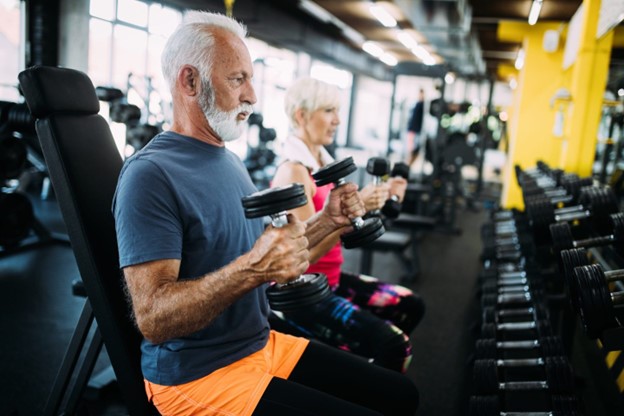
If exercise is so healthy, why doesn’t Medicare always cover gym memberships?
A recent report published by the Centers for Disease Control and Prevention shows that many older Americans aren’t getting the recommended amount of physical activity.
According to the CDC, if you’re 65 or older, your weekly physical activity should include 150 minutes of moderate-intensity aerobic activity, two or more muscle-strengthening sessions, and balance-improving activities.
Physical activity is important at any age, and especially as we get older. Exercise helps the body heal more quickly and prevent injuries, and also supports mental health and brain function.
One way to make exercising easier is to join a gym, which typically offers most or all of the CDC’s recommended activities.
To become a member of a gym in the U.S., the average monthly cost is $58. That figure can vary widely, from $15 per month to some that cost several hundred dollars or more per month depending on the location and type of equipment, classes, and amenities.
In the U.S., 20% of gym members are 65 and older.
Does Medicare pay for your gym membership?
Medicare coverage of gym memberships would seem like a no-brainer, given the importance of physical activity for older adults, right? Nope.
“Original Medicare does not cover gym memberships,” says Jean Brasher, vice president and Medicare specialist at Brasher Brokerage in Delray Beach, Fla.
Why is that, when exercise offers so many benefits?
“Medicare cannot cover fitness, because it’s not related to medical problems,” says Diane Omdahl, author of Medicare for You and cofounder of the Medicare advisory firm 65 Incorporated.
Medicare coverage includes medically necessary services and a small range of preventive services to prevent sickness (such as vaccinations) or detect illness early when treatment is most likely to be helpful.
However, if you’re willing to sign up for a Medicare Supplement insurance plan, also known as Medigap, you may get gym membership and fitness coverage.
Medigap plans generally cost $200–$300 per month, depending on the plan and your location, says Brasher. That’s in addition to your monthly traditional plan, which is $174.70 per month for most people, with a $240 annual deductible. The main function of Medigap plans is to cover out-of-pocket expenses not covered by original Medicare (such as the 20% co-pay and deductibles), she says, and fitness coverage is an added benefit.
As of this writing, Brasher says one insurance carrier, United Healthcare, does offer Medicare Supplement plans that do include extensive coverage of gym memberships and fitness classes—varied by location but possibly including pilates classes, water aerobics, stretching sessions, and more.
Fitness options with this insurance carrier are available throughout the U.S., so if you travel or spend part of the year in another area, or want to check what’s available locally at zero cost, you can input your zip code.
Be aware that you may be limited in the number of monthly classes or the hours you can use certain facilities.
Medicare Advantage coverage of gym memberships
This is one area where Medicare Advantage private insurance plans—which can be lower in price than traditional plans, but often have limited doctor and hospital networks and require prior authorizations—clearly offer more benefits than traditional Medicare, at least in recent years.
“In 2019, CMS [Centers for Medicare and Medicaid Services] opened the door for Medicare Advantage plans to offer supplemental health-related benefits,” including benefits related to fitness, says Omdahl.
Today, according to data from Kaiser Family Foundation, 95% of Medicare Advantage plans offer fitness benefits.
The benefits vary widely, but often cover fitness classes and gym memberships, says Brasher, with many of these Medicare Advantage plans offering zero-cost monthly premiums.
Other fitness expenses covered by Medicare Advantage
Some Medicare Advantage plans have supplemental benefits that cover fitness expenses beyond gym memberships and classes.
For example, Brasher says, one insurance carrier offers a PPO plan which includes an $800 supplemental benefit. “You can buy an Apple Watch, skis, camping equipment—there’s a long list of what qualifies as a recreational benefit,” she explains.
Medicaid coverage of gym memberships
Fitness coverage is not a mandatory type of coverage under Medicaid, but states may offer it.
Free fitness options
Communities often provide free fitness resources to older residents.
Senior centers may offer free health and fitness classes—information on which may be provided by your local Area Agency on Aging.
A word of caution
While fitness is important, Omdahl recommends looking at the big picture when choosing a Medicare plan. “We always advise not to pick a Medicare plan for one of these supplemental benefits,” says Omdahl. “Plans can change, and your needs can change. You have to look at how the plan will work when you need medical care.”
Physical therapy and personal training both play essential roles in helping people improve their fitness, strength, and movement. While they belong to distinct professions with different scopes of practice, education, and training, both can work together to offer comprehensive care and achieve optimal health outcomes. Understanding their differences and how they complement each other can help you make informed decisions about your health and wellness journey.
The Role of Personal Training
Education and Certification: Personal trainers are fitness professionals who work one-on-one with clients or in small groups to achieve specific health and fitness goals. While there are no specific educational requirements to become a personal trainer, many pursue certifications from accredited agencies such as the American Council on Exercise (ACE) or the National Academy of Sports Medicine (NASM). Certifications in first aid and the use of an automatic external defibrillator (AED) are also commonly required.
Scope of Practice: Personal trainers focus on:
- Assessing a client’s fitness level.
- Designing customized exercise programs to achieve goals such as weight loss, muscle strengthening, flexibility, endurance, and improved sports performance.
- Instructing clients on the safe use of exercise equipment and proper exercise techniques to avoid injury.
- Motivating and supporting clients to stick to their programs.
Personal trainers cannot diagnose injuries or health conditions or prescribe rehabilitation programs. Instead, they work alongside clients to enhance their fitness levels and overall health.
The Role of Physical Therapists vs Personal Training
Education and Certification: Physical therapists (PTs) are licensed health professionals who must earn a Doctor of Physical Therapy (DPT) degree from an accredited program, which typically takes three to five years to complete. They must pass the National Physical Therapy Examination and fulfill state licensure requirements. PTs also complete continuing education hours to maintain their licenses.
Scope of Practice: Physical therapists:
- Evaluate, diagnose, and treat movement and pain issues.
- Create personalized recovery programs to improve movement, reduce pain, and prevent disability.
- Treat a wide range of conditions, including back and neck pain, sports injuries, post-surgical healing, age-related issues, joint problems, and more.
- Use various tools and procedures, including hands-on treatment, stretches, exercises, and modalities such as heat or cold therapy, ultrasound, electrical muscle stimulation, and more.
PTs also teach clients home exercise programs to maintain progress and reduce the risk of re-injury after their in-clinic program ends.
How Physical Therapy and Personal Training Work Together
Combining the expertise of physical therapists and personal trainers can provide a comprehensive approach to health and fitness. Here’s how they complement each other:
1. Integrated Care: Physical therapists and personal trainers can collaborate to ensure a seamless transition from rehabilitation to fitness. After completing a physical therapy program, clients can continue working with personal trainers to maintain and further enhance their fitness levels.
2. Personalized Programs: Both professionals design personalized programs tailored to individual needs. A physical therapist can create a rehabilitation plan to address specific injuries or conditions, while a personal trainer can develop a fitness program to achieve broader health goals.
3. Prevention and Maintenance: Physical therapists help prevent future injuries by addressing underlying issues and improving functional mobility. Personal trainers focus on maintaining and building on these improvements, promoting long-term health and fitness.
4. Enhanced Motivation and Support: Working with both a physical therapist and a personal trainer provides clients with a well-rounded support system. Physical therapists offer medical expertise and rehabilitation, while personal trainers provide motivation and accountability to stay on track with fitness goals.
Why Choose The Human Performance and Wellness Center and The Fitness Zone?
At The Human Performance and Wellness Center and The Fitness Zone, we understand the importance of integrating physical therapy and personal training to provide the best care possible. Since 2007, we have been offering transformative physical therapy, personal training facility and other cash based services to clients of all ages. We also collaborate closely with certified personal trainers at The Fitness Zone, ensuring a holistic approach to health and wellness.
Our Commitment:
- Personalized attention and commitment to each client.
- Expertise of our highly trained staff.
- State-of-the-art facilities.
- Listening to client feedback and valuing their input to develop tailored plans.
We know how challenging it can be to perform even the smallest daily activities when experiencing pain and impaired movement. That’s why we work closely with our clients to develop personalized plans that meet their goals. By combining your knowledge of your body with our specialized training, we are confident in achieving optimum healing and improved function.
Conclusion
Both physical therapy and personal training offer unique benefits that can significantly enhance your health and wellness journey. By understanding their distinct roles and how they work together, you can leverage their combined expertise to achieve your fitness, strength, and movement goals.
At The Human Performance and Wellness Center, we are proud of the positive feedback we receive from our clients, highlighting how physical therapy has improved their lives. Contact us today to schedule a free screening and take the first step towards a healthier, more active life.
Women’s Weight Loss Challenge Diet Plan
**Immediately upon waking, you are to drink a 6–8-ounce glass of water with 2 tablespoons of fresh lemon juice, if this could be hot or warm water, it is better. If not just drink it at room temperature. Total daily consumption of water per day needs to be at least 64 ounces. The goal would be to try to consume 1 gallon of water per day.
Meal #1 Breakfast: 7:00am
- ½ cup of egg whites
- 1 whole egg – fresh farm raised would be best.
- 1 cup of vegetables
- ¼ cup nuts or seeds: almonds, sunflower seeds, etc.
Meal #2 Snack: 10:00am
- Protein shake (25 grams of protein – 1 scoop)
- Handful of nuts – ¼ cup walnuts, almonds, sunflower seeds etc.
- 1 cup vegetables
Meal #3 Lunch: 1:00pm
- 2-4 ounces portion of lean meat: chicken breast, fish, turkey
- Salad or vegetables – at least 1 cup
- If you choose a salad, you can have 2 tablespoons of salad dressing.
Meal #4 Snack 4:00pm
- 2 tablespoons of almond butter or peanut butter
- ½ -1 piece of fresh fruit – Granny smith apples are the best.
- ½ – 1 cup of grapes, cherries, etc.
Meal #5 Dinner: 7:00pm
- “Lean and Green Meal” 2-4 ounces of lean meat
- 1-2 cups of vegetables
Meal #6 Nightly Snack:
Only if you are hungry and need to have something to hold you over until morning. Example, deli turkey rolls, Mozzarella cheese and 4-6 brown rice crackers.
******We will continue this diet regimen until you reach a plateau, and your body stops burning body fat. Then we will perform a carbohydrate loading meal once per week. We will continue this approach until you stop losing weight/burning fat once again and then we will do the carbohydrate loading meal twice per week – every third night. The purpose of this is to re-fill our glycogen stores and to help spike your metabolism. We are purposely saving that carb load meal for the last meal of the day, so the carbs get absorbed and used to re-fill the muscle and liver glycogen levels, rather than being burned off as energy.
One of the issues with constantly following a low carb/low calorie diet is that your metabolism slows down as your body gets accustomed to the food intake. This is why a lot of overweight people are not huge eaters, but they have conditioned their bodies to get fat and then they hold onto that stored body fat through poor eating habits and slows metabolisms.
This carb loading meal also serves as a motivational treat as well. The cream of rice with berries or sweet potato with butter tastes so good when you are used to eating protein and vegetables for all your meals. So just in knowing that once and up to two nights per week we have a little indulgence in some tasty/healthy carbs to help make the diet easier to follow.
**Women’s Weight Loss Carbohydrate Loading Meal**
Once per week, on a designated night we will perform a carbohydrate loading; this will replace Meal #5. This carb-loading meal will consist of all the following:
- Bowl of cream of rice or oatmeal with blueberries
- 1 large Sweet potato/yam with butter
- 2 tablespoons of almond butter or peanut butter
**You will perform this once per week for Women’s Weight Loss until you reach another plateau and then we will perform it twice per week or every third day. Once you plateau again, we will begin to cut your portion size down. That is why it is so important to measure our meals.
Building a Fairer, Healthier World
World Health Day is a global health awareness day celebrated every year on April 7th, under the guidance of the World Health Organization, as well as other related organizations.
This is a movement to build a fairer, healthier world. As COVID-19 has highlighted, some people are able to live healthier lives and have better access to health services than others, entirely due to the conditions in which they:
- Are born;
- Grow;
- Live;
- Work; and
- Age.

All over the world, some groups struggle to make ends meet with little daily income. They may have poorer housing conditions and education, fewer employment opportunities, experience greater gender inequality, and have little or no access to safe environments, clean water and air, food security and health services.
Health inequity is not only unfair, it is preventable. That is why the World Health Organization is calling on others to ensure that everyone has living and working conditions that are conducive to good health. At the same time, we urge leaders to monitor health inequities, and ensure that all people can access quality health services when and where they need them.
This Valentine’s Day themed circuit workout contains three circuits, each of which have three strength exercises (upper body, lower body, and core) which are done for 12 reps followed by one minute of cardio. Do the first four exercises, rest as needed, and then go onto the next circuit. Complete all three circuits 4 to 5 times for a full workout. This full body workout will work all your major muscle groups in less than an hour.

Push ups
Starting on your toes and hands, make sure your body is a straight line from your heels to your knees, hips, shoulders, and neck. Your hands should be a bit wider than your shoulders. Slowly bend at the elbows, lowering yourself to the ground. Try to get at low as possible, and then push yourself back up, all the while maintaining that straight line. An easier modification is instead of being on your toes, lower to your knees.
Dumbbell squats
With feet hip width apart and dumbells in your hands at your sides, use the glutes to lower your hips back and down while bending at the knees and ankles. Once you’ve reached the lowest position you can without leaning forward too much or letting the knees collapse in, return to a standing position, again using your glutes to propel yourself.
Bicycle crunches
Lay on your back with your knees bent and your feet flat on the floor. With your hands behind your head and elbows out to the side, bring your feet off the floor so that your shins are parallel to the floor and your knees are bent at a 90 degree angle. Bring your shoulder blades off the floor and alternate bringing your left elbow towards your right knee, and your right elbow towards your left knee. Your feet should look like they’re pedaling a bike.
Butt kicks
Stand with your feet hip width apart and your arms bent comfortably at the elbow. Bend your left knee and bring the heel of your left foot behind you so that it touches your butt. Lower your left foot back down to the ground and repeat with your right foot.
Side shoulder raises
With your arms down at your sides with a dumbbell in each hand, slowly raise your hands away from your body to the side, keeping your arm straight at the elbow. Once your hands reach shoulder level, slowly lower them back down to your sides.
Curtsy lunges
Similar to alternating lunges, instead of stepping straight back with your left leg, you place your left foot behind you and to the right, so that it crosses behind you and return to standing. Repeat with your right foot stepping back and to the left.
Side plank
To perform a side plank, lay on your side with your elbow beneath your shoulder and your forearm on the ground. With your top foot stacked on top of your bottom foot, lift your hips off the floor so that your shoulders, hips, knees, and feet are in a straight line. Hold and then repeat on the other side.
Jumping jacks
Stand with feet together and arms at your sides. Jump both feet apart from each other while raising your hands above your head with straight arms. Jump your feet back together and lower your arms to the starting position.
Overhead press
Stand with your feet hip width apart with a dumbbell in each hand. With your upper arms in a 90 degree angle to your torso and your hands directly above your elbows, lift your hands straight up so that your arms are straight above your head. Slowly lower your hands back down to the starting position.
Step ups
Find something that when you put your foot on it, your knee is at a 90 degree angle. This could be a chair or bench. Step up with your left foot, and pushing off that heel step your right foot off the floor and onto the bench. Immediately step back down with your left foot, followed by your right foot.
Punches
Stand with your feet hip width apart with your left foot slightly forward. Lift your arms up so that your hands are in front of your face with your left hand slightly forward. Punch one hand at a time in front of you, repeating as quickly as possible while maintaining good form.
This post contains affiliate links. Thank you for supporting my blog, I appreciate it!
As always, talk to your doctor before beginning to workout. Honor your body and modify this workout as needed.
Are you doing anything fun tonight for Valentine’s Day? Let me know in the comments.
Valentine’s Day isn’t just for chocolates and flowers. It also can be an excellent opportunity to get moving with this partner workout.
The holiday of love is actually in the top 10 of America’s most-fattening holidays.
So, that’s even more reason to break a sweat! Take your V-Day to the next level with this full-hour partner workout. Grab your valentine (or galentine), and let’s get to it!
WARM-UP
Timed Partner Workout Switches, 60 seconds each:
- Partner 1 doing Sweeping Good Mornings and Partner 2 doing Windmills, then switch.
- Partner 1 doing Squats and Partner 2 doing Push-Ups, then switch.
- Partner 1 doing Jacks and Partner 2 doing Lunges (any style), then switch.
- Partner 1 doing Squat Thurst Lite and Partner 2 doing Broad Jumps, then switch.
ROUND 1
Joint Partner exercises, 90 seconds each, then repeat the list of exercises before moving on to Round 2:
- Wheelbarrow Squats, where one partner is in a Push-Up position and the other partner is holding their feet. As the first partner does a Push-Up, the second partner then does a Squat. Switch halfway.
- Leg Pushes, where one partner is lying on his/her back with legs extended to the sky, while the other partner is standing over the first partner’s head. The standing partner then pushes the lying partner’s legs down repeatedly. Switch halfway.
- Plank Jump Overs, where one partner is in a High Plank position and then lowers down for a Hand-Release Push-Up. When the first partner is flat on the ground, the second partner hops or steps over him/her.
- Wall Sit + Tricep Dips, where one partner is in a Wall Sit position against a wall, while the other partner places his/her hands on the first partner’s knees to perform Tricep Dips. Switch halfway through.
- Squatted Ball Passes, where partners are in a Squat position back to back. Twist to pass a medicine ball or other weight to the other partner. Switch directions halfway through.
- Plank + Sit-Up, where one partner is lying on his/her back with feet flat on the ground, and the other partner is in a Plank position with his/her hands on the other partner’s feet. The lying partner then performs Sit-Ups or Crunches. Switch halfway.
ROUND 2
Counter-Switch Partner Sets, 5 minutes each set, switching back and forth when one partner completes the designated reps of one of the two exercises:
- Partner 1 starts with 20 Heartbeats, while Partner 2 starts with Jump Rope.
- Partner 1 starts with 20 Ribbon Squats, while Partner 2 starts with X-Country Skiers.
- Partner 1 starts with 20 Plank SeeSaws, while Partner 2 starts with Squat Jumps.
- Partner 1 starts with 20 total Side Lunges, while Partner 2 starts with Burpees.
- Partner 1 starts with 20 Kettlebell Halos, while Partner 2 starts with Fast Feet.
- Partner 1 starts with 20 V-Ups, while Partner 2 starts with Jacks.
ROUND 3
Partner Plank-Off, with both partners in their hardest level of a Plank, holding for as long as possible. The first one to come down has to make the other a refreshing protein recovery shake!
And don’t forget to stretch out afterward.
(Southern Italian Poached Fish)
Serves 4 TIME 35 minutes Cooks Country
WHY THIS RECIPE WORKS
“Acqua pazza,” or “crazy water,” refers to the southern Italian tradition of cooking the day’s catch in seawater “Pesce All’Acqua Pazza”. Modern recipes feature longer ingredient lists: Parsley, tomato, white wine, and garlic are common. For the fish, we chose skin-on haddock fillets. The flesh held up nicely during simmering, and the abundant collagen in the skin suffused the broth with rich flavor and body. Halved cherry tomatoes provided sweetness and pops of color. We also liked the addition of white wine, which contributed brightness and light acidity. After just a few minutes, the haddock absorbed the heady flavor of the broth and the broth was enriched by the fish.
Pesce All’Acqua Pazza INGREDIENTS
1½ pounds haddock fillets, ¾ to 1 inch thick (I used boneless, skinless Cod or Shrimp)
1 teaspoon kosher salt divided
¼ teaspoon pepper
2 tablespoons extra virgin olive oil
3 garlic cloves, sliced thin
¼ teaspoon red pepper flakes
1 small onion, chopped fine
1 bay leaf
8 ounces cherry or grape tomatoes (or Sugar Bombs), halved
1¼ cups water
¼ cup dry white wine (Dry Vermouth)
12 fresh parsley stems, plus 3 tablespoons chopped fresh parsley, divided
2 tablespoons capers optional
BEFORE YOU BEGIN
You can substitute skin-on fillets of other firm, white-fleshed fish such as branzino and red snapper for the haddock. Serve with crusty bread.
Pesce All’Acqua Pazza INSTRUCTIONS
Sprinkle haddock all over with ½ teaspoon salt and pepper and set aside.
Heat oil, garlic, and pepper flakes in 12-inch skillet over medium heat, stirring constantly, until garlic begins to sizzle gently, 1½ to 2 minutes. Add onion, bay leaf, and remaining ½ teaspoon salt and cook, stirring constantly, until onion just starts to soften, 2 to 3 minutes. Add tomatoes and cook, stirring constantly, until tomatoes begin to soften, 2 to 3 minutes. Stir in water, wine, parsley stems, and half of chopped parsley and bring to boil. Nestle haddock skin side down in liquid, moving aside solids as much as possible (it’s fine if fillets fold over slightly at ends; liquid will not quite cover fillets). Spoon some liquid and solids over haddock. Reduce heat to low; cover; and simmer gently until fish registers 110 degrees at thickest point, 4 to 7 minutes. Let stand off heat, covered, until fish is opaque and just cooked through (fish should register at least 135 degrees), 3 to 7 minutes.
Divide haddock among 4 shallow soup bowls. Discard bay leaf and parsley stems; stir remaining chopped parsley into broth. Season broth with salt and pepper to taste. Spoon portion of broth and solids over each serving of haddock and serve immediately.
Nutritional Information
Per Serving (Serves 4)
Calories 221 Total lipid (fat) 8 g Fatty acids, total saturated 1 g
Fatty acids, total trans 0 g Fatty acids, total monounsaturated 5 g
Fatty acids, total polyunsaturated 1 g Cholesterol 92 mg Sodium, Na 814 mg
Carbohydrate, by difference 5 g Fiber, total dietary 1 g
Sugars, total including NLEA 2 g Protein 29 g

